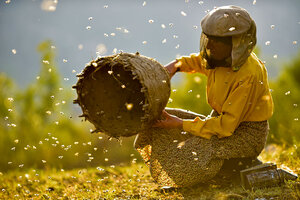‘Honeyland’: The unexpected pull of a documentary about beekeeping
The beekeeper lifestyle chronicled in “Honeyland” is uncommon, yet it speaks to universal truths about survival and human connection.

“Honeyland,” which began as an environmental video for the Nature Conservation Program in North Macedonia, highlights the isolation and heroism of beekeeper Hatidze Muratova.
Courtesy of Neon
One of the great things about documentaries is that they can transport you to places you might otherwise never know about. Certainly the world of Macedonian beekeepers was not high on my must-see list but the highly acclaimed “Honeyland,” which is about that world and so much more, is intensely immersive from the first frame. The lifestyle it chronicles is as remote as possible from our own, and yet it speaks to universal truths about survival and human connection.
Directed by Tamara Kotevska and Ljubomir Stefanov, the film, which contains no narration or on-camera interviews, began as an environmental video for the Nature Conservation Program in what is now known as North Macedonia. When the filmmakers encountered Hatidze Muratova, the last remaining beekeeper in an isolated mountain region deep within the Balkans, the project found its focus. More than 400 hours of footage was shot over a period of three years, during which time Hatidze, caring for her blind, ailing 85-year-old mother, Nazife, in their run-down hut, is encroached upon by a troop of neighbors: Hussein Sam and his wife and seven children and a herd of cattle.
The scenes involving Hatidze before the Sams’ arrival are revelatory. We see how she tends to her bees in the traditional way passed down from her family for generations. Her relationship to the bees is almost familial: She sings to them, is never stung by them, and she makes sure she only takes as much honey as she needs to sell in small quantities at a market about four hours’ walk from her home. Of her sharing with the bees, she is fond of saying, “Half for them, half for you.”
Despite the harshness of her solitary life in an environment with no agriculture, running water, vegetation, or electricity, Hatidze, at least until the neighbors arrive, appears contented. She never married and has no siblings, and her mother’s crotchety demands are unceasing. And yet the connection between mother and daughter is extraordinarily tender. Nazife announces that she has no intention of dying but woefully confesses to Hatidze that she is “just making your life a misery.” But Hatidze has emotional reserves that extend way beyond her caring for bees. Nazife, in a sense, is her queen bee. The love they extend to each other – in one scene, she gently feeds her mother honeyed syrup – is as palpable as the golden daylight that streams into their hovel, or the lamplight that illuminates them at night.
When we see Hatidze in the marketplace selling her honey jars, she has an easeful conviviality. She may essentially live as a hermit, but she has no trepidation about mixing it up with outsiders. She loves the bartering, the byplay; she even indulges herself by purchasing red hair dye. The directors have commented that, much to their surprise, she welcomed their intrusion into her life – that it was always her dream to be filmed. This accounts for the amazing intimacy of the film’s scenes between Hatidze and her mother – scenes which, at times, especially when Nazife is dying, seemed a tad too intimate for me. Some moments, perhaps, should be kept off camera.
Hatidze’s capacity for friendship, at least for a time, comes into play when the Sams arrive. She welcomes the hubbub and the pets and the teens and toddlers roaming about. But then Hussein, who can’t support his sprawling family only with the cattle, takes up beekeeping. Hatidze generously imparts her methods to him but, pressured by money-grubbing marketeers, he disregards the half-for-them-half-for-us rule and wreaks havoc on the region’s beekeeping biodiversity.
I suppose you could read “Honeyland” as an indictment of capitalist greed and its effects on the ecosystem, and there’s some truth in that. But the film is vastly more valuable as a document about an extraordinary life – an extraordinary heroine – and the frail future of the traditions that formed her. It’s the best kind of documentary – an eye-opener and a mind-opener.
Editor's Note: This story has been updated to correct the quantity and units of the footage the filmmakers collected.

